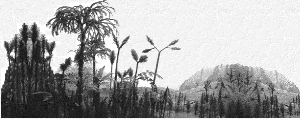Especially in the field of palaeobotany cooperations
have been established with various scientists and research groups. Also
here we would like to name only a few:
-
Prof. Dr. Thomas N. Taylor (Lawrence, Kansas, U.S.A.), who
has been in Münster as a Humboldt-Award winner is our cooperation
partner on fossil fungi.
-
Prof. Dr. V. Mosbrugger and Dr. A. Roth (Tübingen,
Germany)
are our cooperation partners in a joint research project on the form and
function of early land plants
-
Prof. Dr. D. Edwards (Cardiff, Wales, UK) is a cooperation
partner in palaeophysiological studies of Rhynie Chert
plants.
Material for our studies has been collected during several
collecting trips and has been supplied by several colleagues, collection
managers and curators. Support by the late Dr. A.G. Lyon has enabled the
establishment of the Münster Rhynie Chert collection.
Research would not have been possible without financial
support from several funding bodies, especially the Deutsche
Forschungsgemeinschaft.
DFG provides funding for a running project carried out in cooperation with
colleagues from the University of Tübingen. Financial support
for visiting guest scientists was made available by the Alexander von
Humboldt-Stiftung,
DAAD, and the European Committee / TMR Mobility Programme |






